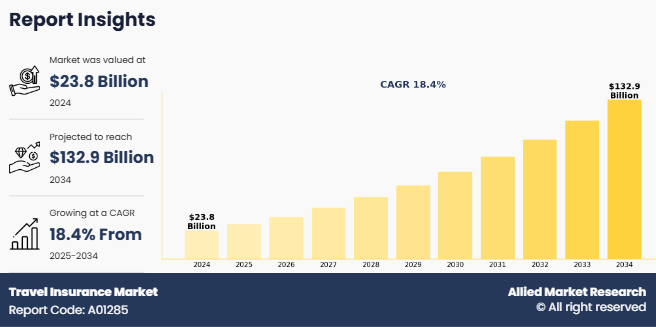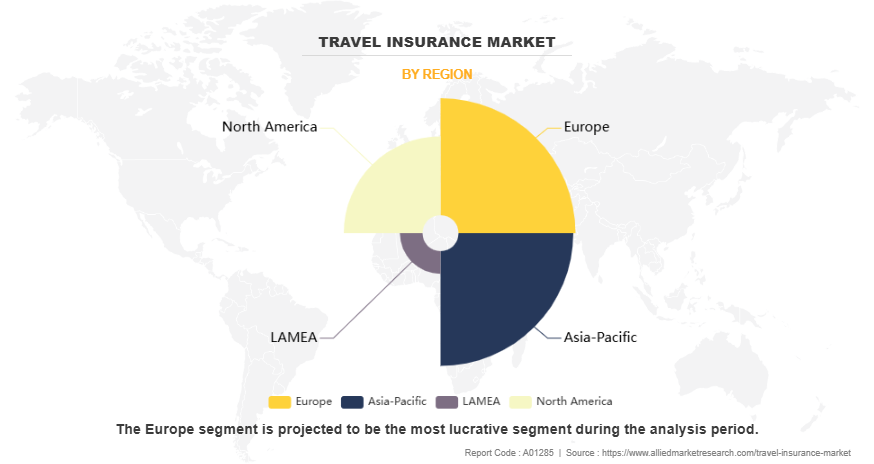Travel Insurance Market Research, 2034
The global travel insurance market size was valued at $23.8 billion in 2024, and is projected to reach $132.9 billion by 2034, growing at a CAGR of 18.4% from 2025 to 2034. The travel insurance market is a specialized part within the broader insurance industry, focused on providing coverage for risks and uncertainties associated with both domestic and international travel. It offers financial travel protection against a variety of disruptions including trip cancellations, medical emergencies, travel delays, lost luggage, and accidental death or injury during travel.

Key Takeaways
By age group, the above 50 years segment held the largest share in the travel insurance market in 2024.
By insurance cover, the one-trip travel insurance segment held the largest share in the travel insurance market in 2024.
By end user, the family travelers segment held the largest share in the travel insurance industry in 2024.
By distribution channel, the railway operators segment is expected to show the fastest travel insurance market growth during the forecast period.
By type, the travel medical insurance segment is expected to show the fastest travel insurance market growth during the travel insurance market forecast period.
Region-wise, Europe held the largest travel insurance market share in 2024. However, LAMEA is expected to witness the highest CAGR during the forecast period.
The core value proposition of travel insurance lies in its ability to provide peace of mind and financial security in uncertain travel environments. As global travel has become more accessible and frequent, the potential for disruptions caused by medical issues, political unrest, natural disasters, airline strikes, or even pandemics has increased, driving demand for travel insurance market. In addition, international regulations and visa requirements in several countries often mandate proof of travel insurance, particularly medical coverage, for entry, further influencing travel insurance market demand.
The travel insurance market includes a wide range of insurance providers, including traditional insurance companies, online aggregators, travel agencies, airlines, and specialized third-party vendors. Rise in proliferation of digital platforms has transformed how travel insurance is marketed, purchased, and serviced, with many consumers now opting for instant policies via apps or integrated offerings during flight or accommodation bookings. Insurtech innovations and personalized, usage-based coverage are also shaping the future of the travel insurance market, making insurance more relevant and accessible to modern travelers.
Segment Review
The travel insurance market outlook is segmented on the basis of insurance cover, distribution channel, end user, age group, type and region. By age group, it is segregated into below-17 years old, 18-30 years old, 31-50 years old, and above 50 years. By insurance cover, it is fragmented into one-trip travel insurance and annual multi-trip travel insurance. This segment further bifurcated into long stay travel insurance and short stay travel insurance. By end user, it is classified into senior citizens, education travelers, business travelers, family travelers, and others. By distribution channel, the market is divided into airlines, banking organizations, ferry operators, insurance brands, online travel agency (OTA), railway operators, travel agents/tour operators, and others. By type, it is fragmented into comprehensive travel insurance, travel medical insurance, and other. By region, it is analyzed across North America, Europe, Asia-Pacific, and LAMEA.
On the basis of type, the global travel insurance market share was dominated by the comprehensive travel insurance segment in 2024 and is expected to maintain its dominance in the upcoming years. This is attributed to its wide-ranging coverage, including trip cancellations, medical emergencies, lost luggage, and travel delays, making it a preferred choice among travelers seeking complete protection. However, the travel medical insurance segment is expected to witness the highest growth due to rise in incidence of medical emergencies during international travel, increasing healthcare costs abroad, and growing awareness about the importance of medical coverage among travelers, especially seniors and students, which future drives the segment growth in the travel insurance market.

Region, the global travel insurance market was dominated by the Europe region in 2024 and is expected to maintain its dominance in the upcoming years, owing to because of the high number of travelers, well-established tourism infrastructure, and strict travel regulations that often require insurance coverage, especially for Schengen visa applications. People in Europe also travel frequently for both business and leisure, which increases the demand for insurance protection. However, the Asia-pacific segment is expected to register the highest CAGR during the forecast period, owing to a growing middle class, and increasing awareness about travel safety and insurance. More people in countries like India, China, and Southeast Asia are now traveling abroad and buying insurance to cover health issues, trip cancellations, or lost luggage.

Competition Analysis
Competitive analysis and profiles of the major players in the travel insurance market include Chubb Limited, Staysure, Just Travel Cover, AXA, Allianz, Aviva Plc, Berkshire Hathaway Specialty Insurance, Tokio Marine HCC., HDFC ERGO General Insurance Company Limited, The Manufacturers Life Insurance Company, Income Insurance Limited, MSIG Insurance (Singapore) Pte. Ltd, Berjaya Sompo Insurance Berhad, Great Eastern Holdings Ltd, Seven Corners Inc, American Express Company, Travel Insured International, Inc., Nationwide Mutual Insurance Company, Assicurazioni Generali S.p.A., and Zurich Insurance Company Ltd. These players have adopted various strategies to increase their market penetration and strengthen their position in the travel insurance market.
Recent News in the Travel Insurance Industry
In July 2024, Allianz Partners Singapore partnered with MoneyHero's subsidiary of SingSaver, to introduce Allianz Travel Hero. The new travel insurance aims to provide consumers with tailored insurance plans and coverage options. Allianz Travel Hero offers premiums as low as $3.33 per day. The insurance covers unforeseen travel disruptions, accidental death and disability, loss of travel documents, personal liability, and more.
In July 2022, Chubb partnered with Royal Brunei Airlines, to offer travel insurance to the airline's passengers. The partnership was launched in Brunei with more countries and territories to follow in subsequent phases
In June 2022, Aviva Plc. extended its partnership with TSB to offer home and travel insurance to TSB's 5 million UK-based customers. The agreement follows a competitive tender process and reflects the success of Aviva Plc. and TSB's existing partnership, announced in 2015. The renewed partnership supports both Aviva Plc.'s and TSB's simplification and digitization strategies.
In February 2021, Chubb announced the launch of a new travel insurance and partnership with Travix, a global online travel company. The partnership offers Chubb's travel insurance plans to customers using Travix websites to make their travel arrangements. Customers can arrange for immediate coverage through Travix websites when booking their trip.
Top Impacting Factors
Driver
Rising Global Tourism and Increasing Travel Frequency
The continuous growth in global tourism and the increasing frequency of travel are among the most influential drivers of the travel insurance market worldwide. Over the past decade, international travel has become more accessible than ever due to a combination of economic development, increased disposable incomes, and the widespread availability of low-cost airlines. Improvements in global connectivity, visa facilitation, and digital travel planning tools have made it easier for people to explore international destinations, travel for work, education, and healthcare, and even engage in adventure or cultural tourism. As people travel more often and to more distant or unfamiliar destinations, the likelihood of encountering unforeseen events—ranging from medical emergencies to travel disruptions—naturally increases, thereby reinforcing the need for reliable travel insurance solutions.
The rising frequency of travel among younger generations and retirees is also a significant contributor to travel insurance market growth. Millennials and Gen Z, in particular, are prioritizing travel experiences and are more inclined to take multiple trips per year, often to diverse and sometimes remote locations. Similarly, an increasing number of retirees are embarking on long-haul or extended trips, where the risks associated with age-related health issues make insurance coverage indispensable. For these demographics, comprehensive travel insurance is not just a safety net but an essential component of travel planning. Multi-trip policies and long-stay insurance plans have gained popularity as travelers look for flexibility and cost-effectiveness.
Increasing Awareness of Travel Risks Post-Pandemic
The COVID-19 pandemic marked a significant turning point in the global perception of travel safety, fundamentally reshaping how individuals assess risks associated with domestic and international travel. Prior to the pandemic, travel insurance was often viewed as an optional add-on, purchased mainly for long-haul or high-cost trips. However, the global health crisis exposed the fragility of travel plans and the broad spectrum of risks that travelers may face ranging from sudden border closures and flight cancellations to emergency medical situations abroad and mandatory quarantines. This heightened awareness has dramatically shifted consumer behavior, transforming travel insurance from a discretionary purchase into a near-essential travel companion.
The experience of widespread trip disruptions and the financial burden of unplanned medical expenses during the pandemic served as a wake-up call for millions of travelers worldwide. Many who previously underestimated the importance of insurance found themselves stranded, dealing with delayed flights, canceled hotel bookings, and expensive treatment for COVID-19 infections in foreign healthcare systems. In response, the travel insurance market witnessed a marked increase in demand for policies that not only offer traditional coverage but also include pandemic-specific benefits such as trip cancellation due to illness, quarantine-related reimbursements, and emergency medical evacuation for COVID-19 treatment. Insurers operating within the travel insurance market have rapidly adapted by introducing more comprehensive, flexible, and easily accessible products that address the evolving risk landscape.
In addition to individual consumers, corporate travel planners, educational institutions, and travel agencies have also become more proactive in promoting or even mandating travel insurance for employees, students, and clients. This institutional shift is significantly contributing to the growth of the travel insurance market, further embedding coverage into the broader travel ecosystem Furthermore, ongoing concerns about new variants of viruses, geopolitical instability, extreme weather events, and global supply chain disruptions have kept the perception of travel risk elevated. These evolving threats continue to fuel demand in the travel insurance market as travelers now prioritize preparedness and peace of mind, especially when venturing abroad.
Restraints
High Cost of Travel Insurance
One of the primary challenges facing the growth of the travel insurance market is the high cost of premiums, which can act as a significant barrier for many potential travelers. Travel insurance policies, particularly those that offer comprehensive coverage, are expensive, especially for older travelers, those with pre-existing medical conditions, or individuals traveling to regions with higher risks (such as areas with health crises, political instability, or natural disasters). High premiums can make consumers hesitant to purchase travel insurance, especially when they view it as an added expense on top of their travel costs. This issue is particularly pronounced for budget-conscious travelers, who may choose to forgo insurance in favor of saving money or assume that the risks associated with travel are managed without insurance.
The cost of premiums often varies based on several factors, such as the traveler’s age, destination, duration of the trip, and the type of coverage required. For instance, comprehensive travel insurance that covers medical emergencies, trip cancellations, lost baggage, and emergency evacuation can be particularly expensive, especially when covering long-term or high-risk travel. In addition, many travelers fail to recognize the value of the coverage they are paying for, perceiving it as an unnecessary cost rather than a crucial safety net. In some cases, travelers may not fully understand the extent of the risks they face while traveling, such as the potential for health emergencies, natural disasters, or travel disruptions, which makes them less likely to invest in travel insurance, which hinders the growth of travel insurance market.
As a result, the high cost of premiums limit the accessibility of travel insurance, particularly among travelers in emerging markets or those who do not regularly travel internationally. Insurers may need to explore ways to offer more affordable and flexible plans, such as pay-per-day coverage or basic policies that cover essential risks, in order to attract more price-sensitive consumers. Furthermore, educating travelers about the long-term value of insurance and offering more affordable options for younger, less affluent demographics could help overcome this cost-related restraint.
Opportunity
Growth of Digital Platforms and Embedded Insurance Models
Government regulations and visa insurance mandates present significant opportunities for growth in the travel insurance market, especially as more countries adopt policies requiring travelers to have adequate insurance coverage as a prerequisite for entry. These regulations ensure that travelers are financially protected while abroad, and at the same time, create a consistent, growing demand for travel insurance market. Countries across the globe are increasingly mandating travel insurance to protect travelers and ease the pressure on their national healthcare systems, making these requirements a key factor driving the growth of the travel insurance market.
One of the most notable opportunities from visa insurance mandates is the increased market penetration and wider customer base for travel insurers. For instance, the Schengen Area visa requirement necessitates that travelers from outside the European Union present proof of travel insurance before they can enter member countries. Similar mandates exist in a variety of countries such as Russia, Cuba, and the U.S., where travelers must have health coverage that includes medical expenses, emergency evacuation, and repatriation in order to be granted entry. These requirements have expanded the number of consumers who need to purchase insurance, including individuals who may not have previously considered insurance essential. As these policies become a standard part of the travel process, travelers are more likely to view travel insurance as a necessary and unavoidable purchase, not just an optional add-on, which further drives the travel insurance market growth.
This trend creates opportunities for insurers to develop new product offerings tailored to meet these legal requirements. For example, insurers can create policies with specific coverage limits or features that align with the visa mandates of certain regions. Many governments set specific coverage thresholds, such as the €30,000 minimum for medical expenses in Schengen visa applications, creating an opportunity for insurers to design streamlined products that meet these specific guidelines. These products can also be customized to cover a variety of traveler profiles, from tourists to business travelers, students, and healthcare tourists, further broadening the reach of travel insurance companies.
Moreover, as the global travel landscape continues to evolve, the scope of visa insurance mandates is likely to expand to cover additional regions and categories of travelers. Some countries have already begun introducing health insurance requirements for specific groups, such as foreign students or expatriates. This broadens the market even further, offering insurers the chance to tap into previously underserved sectors.
Key Benefits For Stakeholders
This report provides a quantitative analysis of the travel insurance market segments, current trends, estimations, and dynamics of the travel insurance market analysis from 2024 to 2034 to identify the prevailing travel insurance market opportunity.
The market research is offered along with information related to key drivers, restraints, and opportunities.
Porter's five forces analysis highlights the potency of buyers and suppliers to enable stakeholders make profit-oriented business decisions and strengthen their supplier-buyer network.
In-depth analysis of the travel insurance market segmentation assists to determine the prevailing market opportunities.
Major countries in each region are mapped according to their revenue contribution to the global travel insurance market.
Market player positioning facilitates benchmarking and provides a clear understanding of the present position of the market players.
The report includes the analysis of the regional as well as global travel insurance market trends, key players, market segments, application areas, and market growth strategies.
Travel Insurance Market Report Highlights
| Aspects | Details |
| Market Size By 2034 | USD 132.9 billion |
| Growth Rate | CAGR of 18.4% |
| Forecast period | 2024 - 2034 |
| Report Pages | 439 |
| By Age Group |
|
| By Insurance Cover |
|
| By End User |
|
| By Distribution Channel |
|
| By Type |
|
| By Region |
|
| Key Market Players | Travel Insured International, Inc., Just Travel Cover, MSIG Insurance (Singapore) Pte. Ltd, Chubb Limited, Staysure, Allianz, The Manufacturers Life Insurance Company, Berkshire Hathaway Specialty Insurance, Aviva Plc, Zurich Insurance Company Ltd., American Express Company, Nationwide Mutual Insurance Company, Seven Corners Inc, Income Insurance Limited, AXA, HDFC ERGO General Insurance Company Limited, Tokio Marine HCC., Great Eastern Holdings Ltd, Berjaya Sompo Insurance Berhad, Assicurazioni Generali S.p.A. |
Analyst Review
The travel insurance market is experiencing significant growth, driven by an increase in number of global travelers, rising awareness of travel risks, and a shift toward digitalization in the insurance sector. The global expansion of tourism, both for leisure and business purposes, has heightened the need for travelers to protect themselves against unforeseen events such as medical emergencies, trip cancellations, lost luggage, or natural disasters. As international travel becomes more frequent and complex, consumers recognize the value of securing comprehensive travel insurance to safeguard against various travel-related risks.
One of the key drivers of the travel insurance market is the rise in global tourism. With the growing affordability of international travel, more people are exploring destinations far from home, which increases the likelihood of encountering unexpected disruptions. The surge in popularity of medical tourism, longer vacations, and multi-destination trips has also expanded the scope of insurance coverage required. In addition, the pandemic has heightened awareness of health-related travel risks, making insurance not just a precautionary measure but an essential travel companion.
Technological advancements have also played a pivotal role in the evolution of the market. The shift toward digital platforms has made it easier for travelers to purchase and manage travel insurance policies. Embedded insurance, where insurance is offered directly during the booking process, is transforming the way insurance is sold and consumed, simplifying the process for consumers. With mobile apps and online platforms, travel insurance is now more accessible, with personalized plans that cater to the unique needs of different travelers. Despite these growth opportunities, challenges remain.
The high cost of premiums for certain travelers, such as the elderly or those with pre-existing conditions, deters potential customers. In addition, a lack of awareness about the importance of travel insurance, especially among younger and first-time travelers, remains a key barrier to market penetration. However, as the global economy rebounds and travel continues to rise, these obstacles are expected to diminish, creating further opportunities for growth in the travel insurance market.
For instance, in January 2025, Zurich Insurance Company (Singapore) Ltd. partnered with ComfortDelGro Corporation Limited, aimed at enhancing travel security for customers through a new offering, Zurich Travel Comfort. This exclusive travel insurance product will be integrated into ComfortDelGro’s ride-hailing platform, CDG Zig, marking a significant milestone in digital-first travel solutions. The Zurich Travel Comfort policy includes exclusive benefits, such as coverage for travel disruptions caused by vehicle breakdowns enroute to Changi Airport. Customers can claim for up to $550 for unexpected expenses, such as accommodation or alternative travel arrangements.
Travel insurance is a type of insurance that protects travelers from financial losses or unexpected problems that can happen before or during a trip.
The base year is 2024 for the travel insurance market report.
The forecast period for travel insurance is 2025 to 2034.
The total market value of travel insurance was $23.8 billion in 2024.
The market value of travel insurance is projected to reach $132.9 billion by 2034.
Loading Table Of Content...
Loading Research Methodology...



